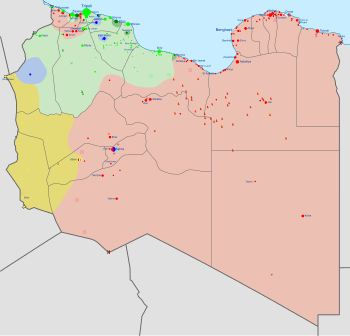Tuareg militias of Ghat
| Tuareg Tribe of Ghat | |
|---|---|
| Participant in the Second Libyan Civil War | |
 Berber flag often used by the Tuareg militias | |
| Active | 2014–Present |
| Ideology | Berberism |
| Area of operations | Fezzan (mainly Ghat District), Libya |
| Opponents |
|
| Battles and wars | Second Libyan Civil War |
Tuareg militias of Ghat are ethnic Tuareg tribal militias, operating in South-West Libya desert areas during the Second Libyan Civil War. The militias rose to prominence in the district of Ghat, which has a Tuareg majority. Gradually, the Tuareg forces expanded their hold also into neighbouring districts. The Libyan Tuaregs are supported by Tuaregs of Mali and groups like Ahmed al-Ansari, with support from the Misratan Libyan Dawn forces.[1] Tuareg militias often utilize the Berber flag.[2]
Tuareg militias are one of a number of factions vying for power in southern Libya, which from 2012 onward has suffered from conflict among Arab, Tabu, and Tuareg tribes.[3][4]
Operations

(For a more detailed map, see military situation in the Libyan Civil War)
2014
Clashes between Tuareg and Tebu tribal militias have repeatedly flared in Ubari at various times during October 2014.[5] The Tebu tribes are affiliated with the Tobruk government in East Libya. On November 5, 2014, a Tuareg militia reportedly seized control of the El Sharara oil field in Fezzan.[6]
2015
In July 2015, clashes between Tuaregs and Tebu tribes reached Sebha, the biggest city in southern Libya, forcing hundreds of families to flee their homes.[7]
Efforts to negotiate a truce between Tuaregs and Tebu in September 2015 halted because the ceasefire was violated.[7]
On 23 November 2015, the Tuareg and Tebu tribal representatives signed a cease fire deal in Doha, Qatar, in the attempt to end the 14 month-long conflict over Obari.[7] Libya Tripoli government welcomed the signing of the ceasefire deal in a statement and thanked Qatar for mediating the process.[7] The ceasefire agreement ended more than a year of violent clashes between the two groups in which more than 300 people had been killed and some 2,000 injured, according to medical sources.[8]
2016
Due to renewed tensions in Ubari, a task force of the Hasawna tribe was dispatched to Ubari in early February 2016 with a mandate to end ongoing clashes between Libya’s Tebu and Tuareg ethnic groups.[8] Reportedly, the move came in line with a ceasefire agreement signed on November 2015 in Doha by Tebu and Tuareg representatives.[8]
References
- ↑ Jazeera, Al. "A fierce battle for control in Libya's desert".
- ↑ "Libya's badlands". 10 January 2014 – via Financial Times.
- ↑ Libya: Who controls what, Al Jazeera (March 22, 2017).
- ↑ Frederic Wehrey, Insecurity and Governance Challenges in Southern Libya, Carnegie Endowment for International Peace (March 30, 2017).
- ↑ "Fresh Tribal Clashes Kill 7 In S. Libya". Haberler. 21 October 2014. Retrieved 21 October 2014.
- ↑ "UPDATE 2-Libya's El Sharara oilfield shut after armed group seizure -sources". Reuters. 5 November 2014. Retrieved 5 November 2014.
- 1 2 3 4 "Rival Libyan tribes sign ceasefire deal in Doha".
- 1 2 3 "Taskforce deployed to S. Libya to end tribal clashes".